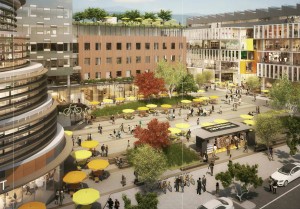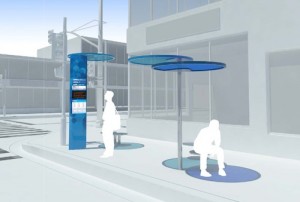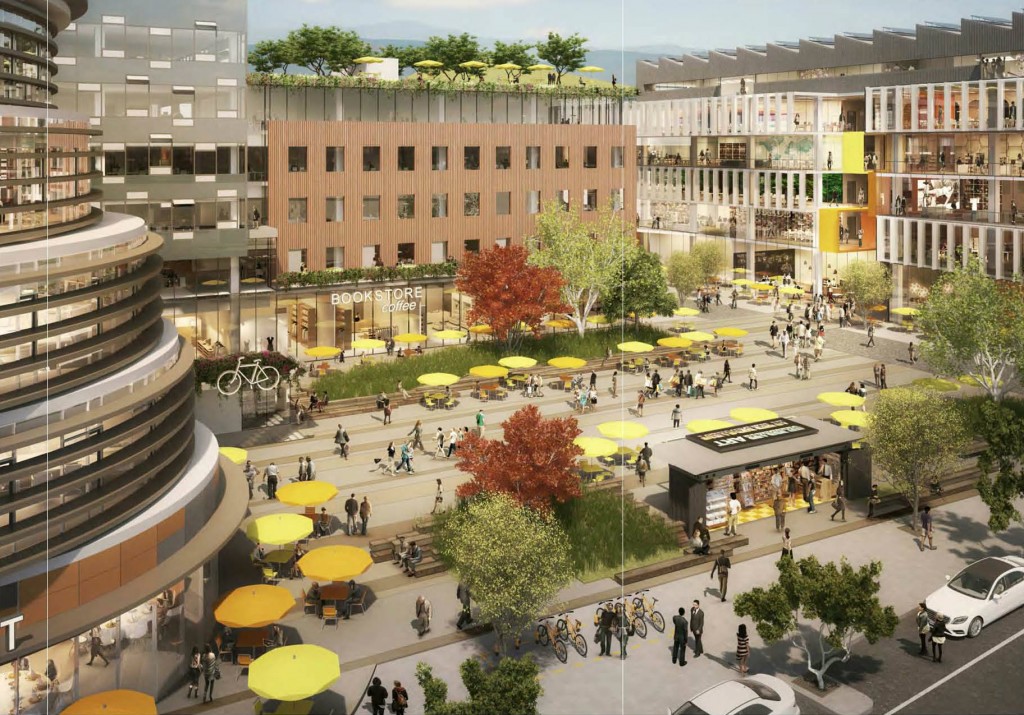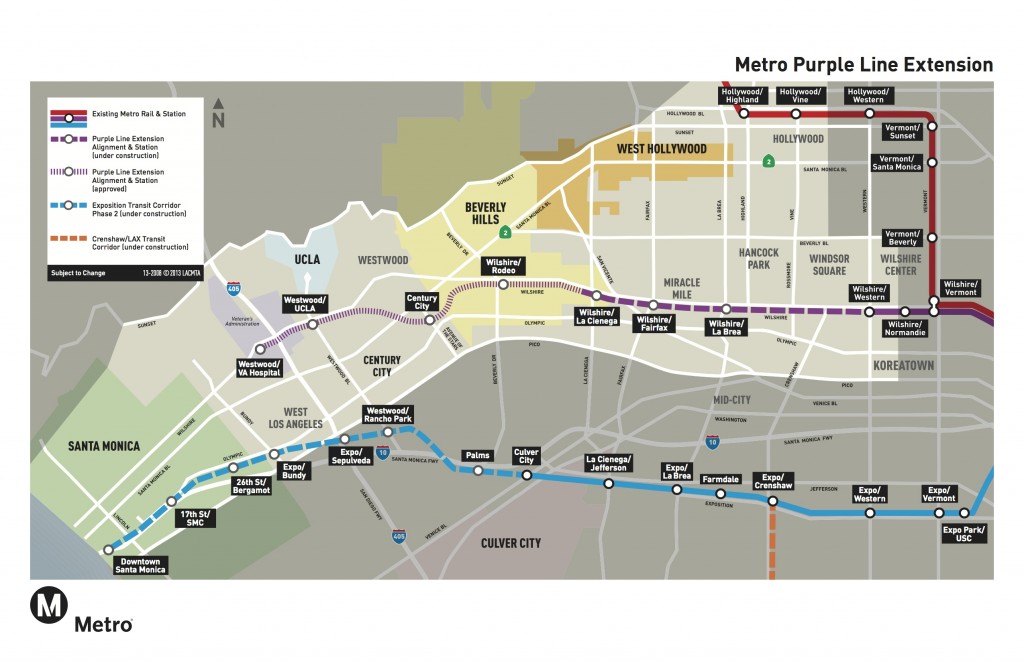 Time to fill in the dotted blue dots on the Expo Line map above to Santa Monica: as of today at noon, they’ll be solid blue as the route becomes operational.
Time to fill in the dotted blue dots on the Expo Line map above to Santa Monica: as of today at noon, they’ll be solid blue as the route becomes operational.
So what’s next? Here’s what I’ll be looking for in the months (and years) to come:
- Long travel times: will people be frustrated by the nearly hour end-to-end ride from downtown Santa Monica to downtown L.A.? Current time projections are 50 minutes, which is a long time for a ride that can take 15 minutes by car with no traffic. The LA Weekly and Los Angeles Times have done a good job of flagging this issue. There are no easy solutions, but at a minimum the City of L.A.’s transportation department should give the trains signal priority so they don’t stop at red lights downtown. Meanwhile, Metro should consider skipping under-performing stations, at least temporarily.
- Collisions: with the train running most at-grade (i.e. street level) and going through some funky intersections from the old railroad right-of-way, will the line experience a lot of accidents like the similarly situated Blue Line, one of the deadliest in the country? And what will the political response be? Easy solutions would be more crossing gates to block traffic, including for those driving in the wrong lane who try to get around single-lane crossing gates (it happens).
- The Expo bike lane: part of the rail extension includes a badly needed dedicated bike path. There’s a gap in the route though, apparently due to neighborhood opposition (what’s new). But the conditions are ripe to make this path even more successful, on a per traveler cost basis, than possibly the rail line next to it. The route is largely flat, the weather is great, and biking is super convenient. So this may be the unsung hero in the whole project.
-
Transit-oriented development along the route: the whole point of rail lines is really about economic development and land use, as Politico covered in an excellent profile on Denver’s burgeoning rail network. Right now, the route covers a lot of relatively low-density areas, and Santa Monica infamously shot down an office and housing project (see rendering) next to one of the new stations, resulting in a low-rise suburban office park to take its place. Will the cities along the route allow new development near the stations? If not, the line will be doomed to under-performance.
- Changing the politics of rail in Los Angeles: with rail now serving a highly visible, major job center in the region, will its existence solidify rail as a politically entrenched force? A bus activist in the Bay Area once told me that nobody would ever scale back BART in favor of buses now, because “BART is too precious.” Will the same thing happen to Metro Rail? As the system begins hauling more people and possibly taking a central role in economic development (subject to #4 above), it may lock in ongoing voter support for the foreseeable future. And not just in the westside. After all, with the eastern county Gold Lines operating, many of those residents will have a stake in accessing jobs in the western part of the county, too.
I’m sure other issues will arise as the system matures, and I’ll try to follow them on this blog. But for now, something to consider as many westside workers and residents of Los Angeles finally get their day to ride the rails.
Los Angeles is about to unveil one of the most consequential transportation projects in recent history. I don’t want to get too hyperbolic, but the coming of the Expo Line light rail transit tomorrow to Santa Monica is, as our current vice president might say, a big f***** deal.
The reason for the import is twofold: first, the location. The westside of Los Angeles County is the most densely populated in the region and the most traffic-choked. Expo, running from downtown Los Angeles all the way to the beach, will finally open that area up to the rest of the train network that’s been growing in fits and starts since 1990. That means a good ridership boost for the whole system and a major alternative to driving for many westside residents and workers.
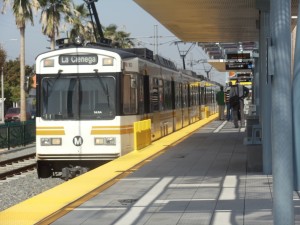 Second, and more intangibly, the train will now serve an influential part of the population, who will finally be seeing a train in their backyard, and a highly visible location for tourists and Angelenos alike.
Second, and more intangibly, the train will now serve an influential part of the population, who will finally be seeing a train in their backyard, and a highly visible location for tourists and Angelenos alike.
Some of the most wealthy and powerful people in Los Angeles, from business to media to opinion leaders, reside in the westside. They are the ones who set much of the tone for the region in its popular discourse and are key to much of its politics and private investment, particularly during a time of tremendous income inequality. As opinion shapers, it matters if they complain about LA “not having any transit” (leaving aside the comprehensive bus network), so a train in their backyard undermines that claim.
In addition, with trains running through the streets of Santa Monica and along Interstate 10, this line will be a visible symbol of the ongoing transformation in Los Angeles’s housing patterns, transportation options, and self-image. Some of the most powerful people in the region will be seeing it firsthand, as well as the legions of tourists from around the world (and the region) who visit downtown Santa Monica and nearby areas.
Ultimately, actions and investment matter more than symbols, and the everyday county voter has certainly been the key to funding these investments. But images and impacts are mutually reinforcing, and the symbolism of Expo — as much as the ridership boost and potential for neighborhood development along the corridor — may matter just as much in the long run.
All in all, it makes tomorrow a momentous day in the history, and future, of transportation and development in Los Angeles.
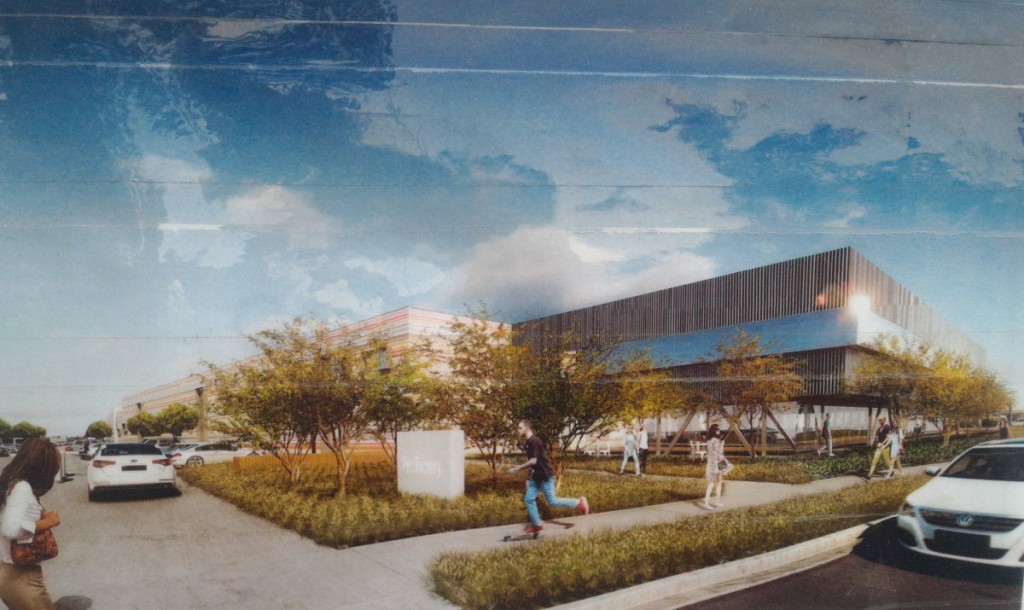 The sad saga of the doomed transit-oriented, pedestrian-friendly complex at the former Papermate site, adjacent to the new Santa Monica Expo Line, just got sadder.
The sad saga of the doomed transit-oriented, pedestrian-friendly complex at the former Papermate site, adjacent to the new Santa Monica Expo Line, just got sadder.
After wealthy no-growthers in Santa Monica torpedoed the badly needed housing and office proposal, the new site owners are building a bunch of office lameness:
The Bergamot Transit Village saga is likely to end this week with a whimper as plans to turn the seven-acre site, once slated to become a mixed-use neighborhood across from the Expo Line 26th Street station, into a suburban-style office park continue to move forward.
The new plans, which the Architectural Review Board (ARB) will consider today, call for simply reoccupying the abandoned Papermate factory as office space as well as adding an additional 7,400 square feet to the existing buildings, bringing the total amount of office space to 204,000 square feet.
The plans will also add a one-story subterranean parking structure to the site, according the city’s website. It is still unclear if Clarion will add a sidewalk on the south side — facing the Expo Metro Rail station — of the parcel where there currently isn’t one. It also looks as though the new plans won’t be breaking up the superblock on which the former Papermate factory sits.
So no new housing, no pedestrian options, and no new neighborhood to take advantage of the multi-billion dollar transit line.
This outcome is a good example of how local politics is making California unaffordable and unlivable for future generations.
As a Councilmember, I proposed an amendment to remove the dividers, saying they were unfriendly and anti-social. There would be many individual chairs for people who wanted to sit alone. Therefore it made sense to keep the benches open ‘for the sake of romance’ and couples who wanted to sit close, and ‘for the comfort of people of all sizes, and their stuff.’
This amendment was not deemed friendly by the maker of the main motion, who asked that it be voted upon separately. First-year Councilmember Kevin McKeown seconded my amendment, saying he supported ‘romantic cuddling’; adding that since the approved design would apply city wide, it would also be better for the neighborhoods to have “the added comfort factor of no dividers for their stops.”
Feinstein was describing a vote back in 1999, but he’s worried that Santa Monica staff may start eliminating these undivided bus benches for the Big Blue Bus stops without a proper discussion (see the new bus stop design rendering above). The fear is that homeless people will use the benches, but the evidence doesn’t seem to support the concern so far.
Meanwhile, romantically cuddle while you can at the Big Blue Bus stop bench.
Santa Monica is about to get a multi-billion dollar rail line and is sitting on some of the most desirable real estate in California. Yet like many other coastal communities, homeowners there are starting to shut down any new housing developments, even when they’re well-planned, near transit, and providing badly needed housing.
Jason Islas at Santa Monica Next sat down with me for an extended interview about my former hometown. You can read Part I here. Here’s a snippet:
You now start to see the backlash to plans that had been put in place a few years before. So, you see, essentially, a lot wealthy homeowner groups, to my understanding funded by some businesses for competitive reasons, organizing and hiring attorneys to shoot down a badly needed development project with a lot of new housing and great transportation improvements for the city, to shoot that down through the threat of voter initiative, I think that was really a key turning point, not just for Santa Monica, but for all of Los Angeles.
The region is now spending tens of billions of dollars on rail expansion and if the locals don’t allow development around those transit stations, it’s essentially a waste of money. It’s a waste of the entire county’s investment if we don’t allow the development to happen because, then, you aren’t going to get the ridership numbers that you need. You aren’t going to see the development patterns that mean people will have more jobs, homes, and services in that immediate area to take advantage of the [rail] line.
It’s a real tragedy, certainly for L.A. County and it sends a chilling signal across California to developers who might want to take advantage of these rail transit areas and build neighborhoods and communities that really work with the transit system.
If they aren’t allowed to do it because of a citizen revolt of all the homeowners who are already established in the neighborhood who don’t want any new residents, then we’ve got a real problem because what that does is reinforce the status quo. The status quo doesn’t provide enough housing for people, it creates a lot of economic inequality and environmental degradation. Those trends are just getting worse.
Many thanks to Santa Monica Next for the opportunity to share my views. I’ll post Part II when it’s available.
An unfortunate vote last week by the Santa Monica City Council will keep major boulevards in the desirable coastal city from being redeveloped, underscoring the anti-housing policies in coastal California that is driving up rents and home prices.
Wilshire and Santa Monica Boulevards in Santa Monica are major transit thoroughfares but feature many low-rise, single story buildings. Back in 2010, the city developed a plan to encourage multi-story housing in corridors like these. But with last week’s vote, which will affect an ordinance to be voted on in a few weeks, those kind of projects will be almost impossible to build under the city’s approval process.
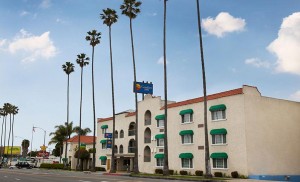
This hotel is likely to be the densest housing built on Santa Monica Boulevard for the foreseeable future
Why does this matter? Because coastal cities like Santa Monica in California have not been doing their fair share to build housing, leading to hugely expensive housing costs and exacerbating inequality for those who can’t afford to live on the coast.
Not to mention that Santa Monica is about to open the multi-billion dollar Expo light rail line, subsidized by the region’s taxpayers, which requires more residents and workers around the station areas to be cost-effective.
Coupled with the city’s rejection of a major office and housing complex by a future Expo Line station, and my former home is sadly becoming a NIMBY poster child.
A major commercial and housing center, proposed for a future rail transit station in Santa Monica, was killed last night by the Santa Monica City Council. The Council had previously approved the project by one vote, but Councilmember Gleam Davis switched her vote to oppose.
Affluent residents of the seaside town (my former home for eight years) organized a citizens petition to stop the development, getting more than ten percent of the registered voters to sign.
Even without this vote, the citizen drive was likely to be successful, and if not, the homeowners group had hired attorneys to litigate the project to death. But the city council vote is surely disappointing to those who would like to see Santa Monica, and greater Los Angeles, channel growth around the rail network. Santa Monica residents are benefiting from a multi-billion dollar rail investment but refuse to allow new residents and workers to take advantage of that system.The fight is another example of how wealthy and sophisticated homeowner groups can prevent these sensible projects. They hired attorneys, formulated political and legal strategies to oppose the project, and enlisted rival businesses and wealthy residents to fund a petition drive.
What’s next? The developers will go back to the drawing board, reoccupy the site, or build according to the limited existing zoning. But far worse is the potential chilling effect this could have on development opportunities around rail transit throughout the region. Why would developers want to gamble their money on transit-oriented projects with this much uncertainty and neighbor opposition? The result will be more sprawl and traffic as development is pushed out to the hinterlands.
It all reminds me of this scene from The Big Lebowski (just substitute Santa Monica for Malibu):

